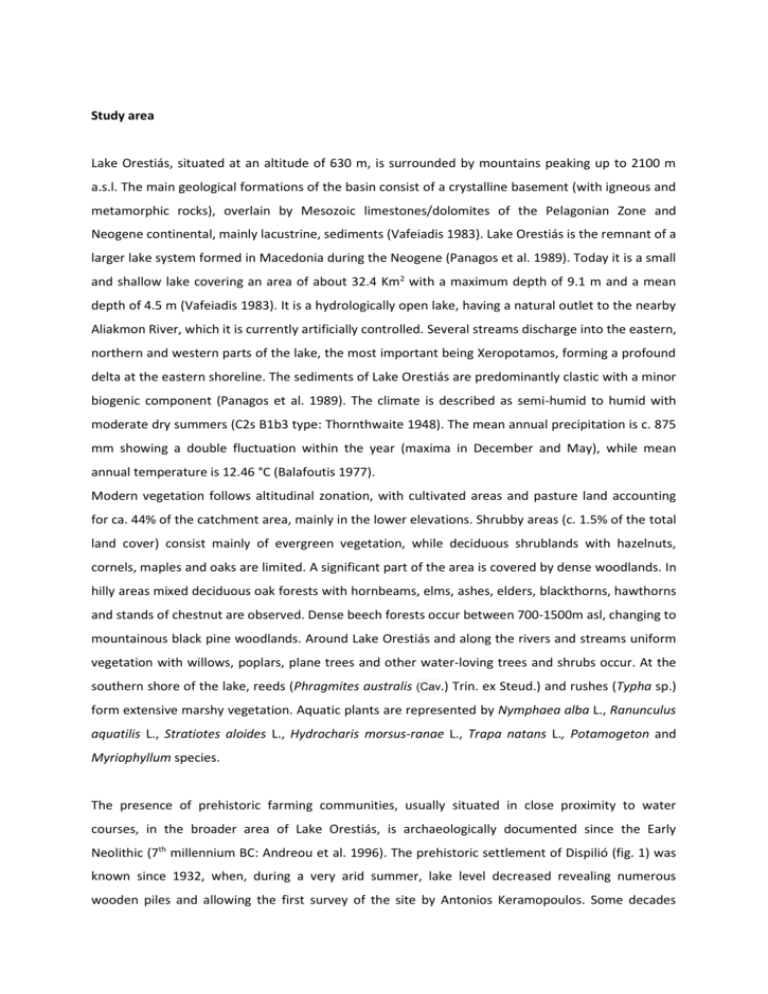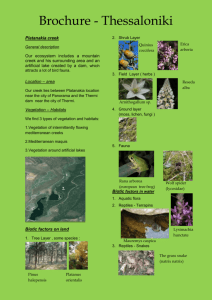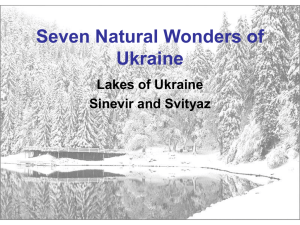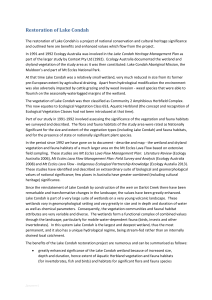Study area Lake Orestiás, situated at an altitude of 630 m, is
advertisement

Study area Lake Orestiás, situated at an altitude of 630 m, is surrounded by mountains peaking up to 2100 m a.s.l. The main geological formations of the basin consist of a crystalline basement (with igneous and metamorphic rocks), overlain by Mesozoic limestones/dolomites of the Pelagonian Zone and Neogene continental, mainly lacustrine, sediments (Vafeiadis 1983). Lake Orestiás is the remnant of a larger lake system formed in Macedonia during the Neogene (Panagos et al. 1989). Today it is a small and shallow lake covering an area of about 32.4 Km2 with a maximum depth of 9.1 m and a mean depth of 4.5 m (Vafeiadis 1983). It is a hydrologically open lake, having a natural outlet to the nearby Aliakmon River, which it is currently artificially controlled. Several streams discharge into the eastern, northern and western parts of the lake, the most important being Xeropotamos, forming a profound delta at the eastern shoreline. The sediments of Lake Orestiás are predominantly clastic with a minor biogenic component (Panagos et al. 1989). The climate is described as semi-humid to humid with moderate dry summers (C2s B1b3 type: Thornthwaite 1948). The mean annual precipitation is c. 875 mm showing a double fluctuation within the year (maxima in December and May), while mean annual temperature is 12.46 °C (Balafoutis 1977). Modern vegetation follows altitudinal zonation, with cultivated areas and pasture land accounting for ca. 44% of the catchment area, mainly in the lower elevations. Shrubby areas (c. 1.5% of the total land cover) consist mainly of evergreen vegetation, while deciduous shrublands with hazelnuts, cornels, maples and oaks are limited. A significant part of the area is covered by dense woodlands. In hilly areas mixed deciduous oak forests with hornbeams, elms, ashes, elders, blackthorns, hawthorns and stands of chestnut are observed. Dense beech forests occur between 700-1500m asl, changing to mountainous black pine woodlands. Around Lake Orestiás and along the rivers and streams uniform vegetation with willows, poplars, plane trees and other water-loving trees and shrubs occur. At the southern shore of the lake, reeds (Phragmites australis (Cav.) Trin. ex Steud.) and rushes (Typha sp.) form extensive marshy vegetation. Aquatic plants are represented by Nymphaea alba L., Ranunculus aquatilis L., Stratiotes aloides L., Hydrocharis morsus-ranae L., Trapa natans L., Potamogeton and Myriophyllum species. The presence of prehistoric farming communities, usually situated in close proximity to water courses, in the broader area of Lake Orestiás, is archaeologically documented since the Early Neolithic (7th millennium BC: Andreou et al. 1996). The prehistoric settlement of Dispilió (fig. 1) was known since 1932, when, during a very arid summer, lake level decreased revealing numerous wooden piles and allowing the first survey of the site by Antonios Keramopoulos. Some decades later, in 1964, the field survey of Nikolaos Moutsopoulos confirmed the existence of the settlement and mapped the pile distribution at the southern part of the lake, both on the shore and in the lake. Systematic archaeological excavations have started at the terrestrial site of Dispilió in 1992 by the Aristotle University of Thessaloniki under the direction of Georgios Hourmouziadis. References Andreou S, Fotiadis M, Kotsakis K. 1996. Review of Aegean prehistory V: The Neolithic and Bronze Age of northern Greece. Am J Archaeol100: 537–597. Balafoutis C. 1977. Contribution to the study of the climate of Makedonia and west Thrace. PhD dissertation, Aristotle University of Thessaloniki, Greece (in Greek). Thornthwaite CW. 1948. An approach toward a rational classification of climate. Geogr Rev 38: 55-94 Panagos A, Conispoliatis N, Varnavas S, 1989. Texture and composition of the Lake Kastoria sediments. Ann Geol Pays Hell XXXIV/1: 105-122. Vafeiadis P. 1983. Hydrogeological study of the Kastoria basin. PhD Thesis, Aristotelian University of Thessaloniki, Greece.











